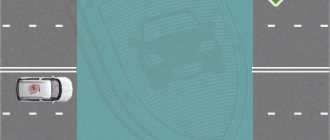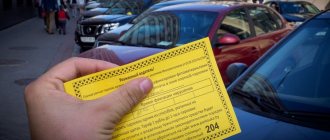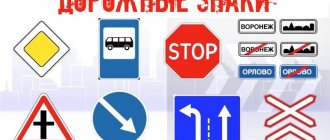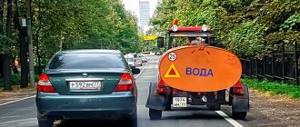Author: ARON
17 January 2021 13:20
Community: Autoworld
Tags: traffic rules reminder, markings
8825
5
There is nothing in the traffic rules that was done just for fun or for beauty. Especially when it comes to road markings.
0
See all photos in the gallery
For a second, it is the most effective tool for regulating relations between motorists and pedestrians. Yellow markings occupy a special place in the rules today. There are three schemes in which yellow is used as a mandatory color. In another, yellow is the recommended color.
What types of road markings exist by color and their designations
All types of road markings are divided into two large groups:
- constant;
- temporary.
Another criterion used to separate this type of designation is the color of the paint applied to the asphalt. To make the signs on the road more visible and more contrasting, white is used, however, in some cases lines of yellow, orange, blue and other colors are used.
According to the requirements of GOST 51259-2018, the following colors can be used on the roadway:
- White and yellow - to create noticeable dividing lines separating oncoming and passing flows. Yellow is more visible under a layer of snow or in bad weather conditions. Also, this shade is used to make “waffle irons” at intersections, places with prohibited parking and to mark pockets for public transport.
- Blue - used to delimit traffic in areas of multi-lane intersections and determine the boundaries of parking lots. The priority of this marking is determined not by its color, but by its shape: only a broken line can be crossed with impunity.
- Orange – used for temporary delimitation of traffic lanes. Used during repair work and has priority over road signs.
- Black - applied exclusively to vertical structures (curbs and pillars), not for lines on asphalt.
Why were the changes introduced?
The use of yellow color when marking is practiced in many countries around the world. It has been proven that the human eye perceives this shade better than white. This becomes especially true if it is raining outside and there is thick fog. When visibility is poor, the white color blends in with the snow cover and ice. Yellow is not. Based on this, the Ministry of Transport officially recommended that road organizations use it. According to the creators of GOST 51256-2018, the new type of lines should perform the same function as white intermittent markings. Yellow color is planned to be used in those regions where cloudy weather is often observed and there is a lot of precipitation.
One question remains: if changes have not yet been made to the Traffic Rules, is it necessary to follow what the yellow intermittent markings prescribe? Yes need. At the same time, we also must not forget about the signs.
By the way, the yellow center line can be solid (marking 1.1). Overtaking through it, as well as through the white one, is strictly prohibited. Some believe that since the traffic rules do not mention this type of marking, this can be appealed in court. Such reasoning is naive and may result in the deprivation of your driver's license. Moreover, the yellow color is precisely used so that the motorist can see the ban in any weather conditions. Therefore, it’s still not worth playing with fire. And adjusting the text of the Road Traffic Rules is most likely a matter of the near future.
zen.yandex.ru
What should the yellow markings be like?
If yellow markings belong to the category of permanent designations, then they may indicate:
- pockets designed for boarding/disembarking public transport passengers;
- places where parking and stopping of vehicles is prohibited, in addition to signs 3.27 and 3.28;
- manholes, storm drains and drains on the roadway (extremely rare).
Types of road markings
The yellow line on the asphalt can be made in several ways:
- Solid. It is used to mark the roadside and is applied 20 cm from curbs or sidewalks for pedestrians. Used for places where parking of vehicles is prohibited, together with the signs “Stopping is prohibited” and “Parking is prohibited”. Occasionally used as a stripe to separate oncoming traffic (similar to a solid white line). The latter option is used in regions with snowy winters for better visibility.
- In the shape of a zigzag. According to paragraph 1.17 of the traffic rules, a broken line indicates the location of a public transport stop. For other road users, parking in the specified zone and 15 meters from it is prohibited. Also, reversing and turning around are prohibited in this area.
- Broken line. When applied on the roadsides and edges of the sidewalk, it means a parking ban (clause 1.10 of the traffic rules). On country roads, such a sign on the right side prohibits driving on the side of the road.
- In the form of squares or “waffle irons”. They are used only at the intersection of roadways to indicate a zone where stopping is prohibited.
Application options
Yellow markings can be applied as follows:
- horizontally - this group includes all types of markings on asphalt: solid, broken and broken lines;
- vertically. Yellow color is used in this way extremely rarely. It can indicate dangerous areas (protruding hatches or poles), and the yellow color can be applied to curbs.
Orange dividing strip. What does yellow marking mean?
When ignoring the marking requirements, the driver violates the traffic rules twice - ignoring the prohibition sign and prohibiting the vehicle from moving along the side of the road ().
Exceptions
In cases arising from unforeseen circumstances, it is permissible to ignore the yellow stripe.
This may include:
Amount of fine for violation
Ignoring yellow markings near the roadside is regarded as a violation (Government Decree No. 1090 of October 23, 1993).
For ignoring signs classified as prohibiting, a fine of 1,500 rubles will be imposed. ().
For residents of capital cities, the fine is 3,000 rubles. ().
Ignoring yellow markings applied in addition to other markings or road signs can also be assessed under other articles:
According to Part 5 of Article 12.15 of the Code of Administrative Offenses of the Russian Federation, introduced, in the event of a repeated similar traffic violation, the driver faces a fine of 5,000 rubles. when a violation is detected by technical means () or deprivation of rights for up to 12 months, if the violation is established by the traffic police crew on duty.
In cases of disagreement with the collection
In case of disagreement with the decision, the car owner again has 10 days to submit an application to a higher authority or pay a fine within 60 days from the date of the decision.
It is worth noting that when you receive a letter notifying you of a fine, you also have 10 days to pair it.
The fine for violating traffic rules recorded by technical means is paid by the car owner, regardless of the person driving the vehicle at the time of the violation.
The color of horizontal markings is of great importance for traffic rules. Failure to comply with its requirements may result in penalties, including the loss of your driver's license.
To comply with traffic rules, it is enough to remember that the rules provide for only 3 types of yellow markings on the edge of the road (1.4, 1.10 and 1.17).
In other cases, the marking can only be orange, and its requirements have priority.
You searched for: yellow markings
Horizontal road markings are presented predominantly in white. However, the Traffic Rules also provide for three options for yellow markings. One of them is markup 1.4.
The main thing that the driver must remember is that the “yellow solid” marking line at the place where it is drawn categorically prohibits stopping (and, consequently, parking) vehicles. This is its purpose.
Marking 1.4 is applied either to the edge of the roadway or on top of the curb.
There are cases when a “yellow solid” marking line is used in combination with the “ ” sign (3.27).
In this case, the driver must remember that the coverage area of the prohibitory sign will be limited to the place where the “yellow solid” marking line ends. In other words, in the situation indicated in the figure, the driver can stop or park his vehicle, because the sign has already ceased to be valid.
Thus, marking 1.4 (or “yellow solid line”) is used to prohibit stopping and parking of vehicles in the area where it is applied. When used together with the “No Stopping” sign, marking 1.4 limits the sign’s coverage area.
- road markings 1 4
- yellow marking line
- traffic marking 1 4
- marking line 1 4
In the commentary to markings 1.4, we already noted that the most popular color used for horizontal road markings is white. But there are three exceptions to this rule.
One of them is the already mentioned “yellow solid” marking line, which prohibits stopping and parking of vehicles at the place where it is applied (on the roadway or on top of the curb).
Let's get acquainted with the second exception - the “yellow dashed” marking line 1.10, which, like 1.4, is applied to the edge of the roadway or along the top of the curb.
Agree that it is not at all difficult to guess that if marking 1.4 prohibits stopping and parking of vehicles, then marking 1.10 prohibits only parking.
The rules provide for the case of joint use of marking 1.10 and the “ ” sign (3.28). This combination means the following: the coverage area of the prohibitory sign will end at the place where the “yellow dashed” marking line ends.
And one last thing. The driver must remember that prohibiting parking does not mean prohibiting stopping.
Thus, marking 1.10 is used to prohibit the parking of vehicles at the place where it is applied. And when using a “yellow intermittent” sign together with a “No Parking” sign, the sign’s coverage area will be limited precisely to the place where the markings are applied.
Source: https://resalt.ru/traffic/orange-dividing-strip-what-does-yellow-marking-mean.html
Do cameras record violations of road markings?
In modern conditions, there are two types of offenses related to crossing yellow markings, which are recorded by automatic cameras:
- Exit and drive along the side of the road marked with a yellow line. In this case, the type of shoulder does not matter: asphalt or unpaved. Thanks to the cameras, the number of drivers who avoid traffic jams on the side of the road is reduced. The fine for such a violation is 1,500 rubles.
- Departure and stop at the “waffle iron”. Stopping at the intersection is prohibited; markings of intersecting yellow lines are used to indicate the area where the restriction applies. In order for such a stop to be considered an offense, it is necessary to leave or not have time to leave the marked area after the activation of the prohibitory traffic light signal. The penalty for violators of this rule is 1000 rubles.
Possible fine for violation
For violation of yellow marking requirements, administrative liability is provided:
- intersection of a single line (solid or broken). In Moscow or St. Petersburg it is punishable by a fine of 3,000 rubles; in other regions of Russia the fine is 1,500 rubles. For parking in this area, the violator’s car may be towed to the impound lot;
- for ignoring the benefits of public transport that departs from a broken line (stop) - a fine of 500 rubles;
- ignoring traffic rules requirements to give way to pedestrians crossing the road along a yellow zebra crossing - a monetary penalty of 1,500 rubles;
- turning around or reversing in an area marked with a zigzag - 500 rubles;
- overtaking on a yellow zebra crossing, crossing a solid line dividing traffic flows - a monetary penalty of 5,000 rubles or deprivation of the right to drive for up to six months;
- leaving and stopping at a “waffle iron” at a prohibiting traffic light – a monetary penalty of 1,000 rubles;
- leaving and driving along the side of the road while ignoring the yellow line on the right edge - a fine of 1,500 rubles.
Yellow markings on the road, on the side of the road, along the curb: what does it mean?
Novice drivers and experienced motorists know very well that road traffic is regulated by special signs, and markings are not only permanent, but also temporary. Its main colors are yellow, white and orange.
But for beginners it is not always clear - what do yellow markings on the road mean? The rules state that white and yellow markings are used as permanent markings; the temporary stripe is drawn in orange.
Fines and other unpleasant situations can be avoided if you know what the yellow markings along the curb mean.
What does the yellow line on the road mean?
What do yellow markings on the road mean? Road markings are a special designation that is used to guide both cars and pedestrians. Thanks to this method, traffic zones are demarcated, parking areas are designated, and the like.
The horizontal plan is marked in two primary colors: white and yellow. Of course, the second option is more often used. There are 3 types of these.
Yellow road markings indicate:
- a specific place where you can stand and stop;
- area of the road on which stopping of vehicles is prohibited.
A car owner who sees markings of this color can come to the very simple conclusion that special rules apply here. Almost always this is a ban on both parking and stopping, except for special vehicles.
These lines are marked by special services. They do this according to certain GOST standards both in cities and on high-speed highways.
What types exist
Each motorist, after reading this information, will be able to draw certain conclusions for himself and characterize any yellow lines on the road.
Let's look at each of them separately:
- A solid single line - it can be seen from the edge of the roadway, it is located on top of the curb. It is always located in parallel. Yellow markings on the road along the side of the road prohibit stopping and parking of vehicles. Very often this line can be seen next to the “No Stopping” sign installed at the side of the road. In this case, the sign will end its action where the marking ends.
- Broken yellow marking line - located and applied in exactly the same way as the first type. A yellow broken line marking on the side of the road means that parking on this road section is prohibited, but stopping is permitted. A motorist can stop next to the dotted line for about 5 minutes, but only if he is boarding/disembarking passengers or unloading/loading cargo. The markings can be used in conjunction with the “No Parking” sign.
- Yellow “zigzag” - only minibuses or passenger taxis can stop on this section of the road.
Passenger cars are prohibited from standing or stopping in this place, as well as in the areas before and after this marking. In addition, you cannot make turns or drive in reverse. The car owner must give way to minibuses that are leaving the stop.
These 3 types of markings are basic; they can be seen in absolutely any city and place.
Waffle iron markings
In 2021, from the end of April, changes came to the rules. After some time, the “waffle iron” will be applied in all cities. Turning to the traffic rules, we can say that the driver who stops for it will definitely receive a fine, and a rather large one.
About 30 meters before the “waffle iron” you can see a warning sign. It is very easy to recognize - on a dark background there is a square with two intersecting lines.
If a motorist, without paying attention, nevertheless drives into the markings, then a fine will be applied to him. At each intersection with this marking, a camera is installed that records offenses. Thanks to the “waffle iron,” it is planned to relieve traffic congestion.
What fine can be applied
Surely every car owner is interested in knowing what fines are applied for parking or parking in the wrong place on yellow lines.
Current fines for violating yellow markings:
- If a continuous or intermittent single yellow marking is violated, the car owner will be fined 1,500 rubles, and in Moscow and St. Petersburg - at least 3,000 rubles. But that's not all - the car is also towed to the impound lot.
- If, while driving past a zigzag, a motorist does not give way to a minibus, then he will also be fined in the amount of 500 rubles.
- If a pedestrian moves along a yellow zebra crossing and the car owner does not let him through, the fine will be 1,500 rubles.
- If the driver stops close to a pedestrian crossing or a stop, a fine will be applied in the amount of 1000 rubles, in Moscow and St. Petersburg - 3000. The vehicle is also evacuated to the impound lot.
- A fine of 500 rubles is applied if a motorist turns around or starts moving in reverse on a pedestrian zebra crossing.
- If a motorist overtakes at a pedestrian crossing, he will face a fine of 5,000 rubles or even deprivation of his driver’s license for a period of 4 to 6 months. If the violation was committed repeatedly, then up to 12 months.
We can conclude that for violating the marking lines, the fine varies from 500 to 5000 rubles, or the motorist is completely deprived of his driver’s license for up to a year.
Do cameras record violations of road markings?
Cameras help traffic police officers track offenders on the roads, that is, thanks to them they can record speed and other violations. The camera helps resolve many controversial situations. So, if you study the statistics, then approximately 32% of the offenses recorded by the camera turn out to be false.
A lot of things affect how a camera works. Therefore, it may fail. This could be weather conditions or any current situation. First, the device records the speed of the car. After this, the system calculates how fast he was moving.
Even the newest cameras, manufactured using modern technologies, can malfunction and provide false information.
This may be due to the following reasons:
- the machine is faulty;
- repair work is being carried out;
- the passage is littered with construction materials;
- there are any unevenness on the road surface.
It often happens that the shadow of a vehicle, which fell on a solid line, was displayed on the cameras and the system considered this a violation, while recording the license plate number of the car. This recording is considered an error, so no fines will be applied to the motorist.
Electronic fines are processed manually by traffic police officers. Therefore, the risk of the presence of a human factor is also possible.
The Strelka radar is capable of calculating not only the speed at which vehicles are moving, but also recording the intersection of a solid line. Moreover, it is installed not only on a permanent basis, but also on a temporary basis, using tripods.
If the line is not visible, is the penalty applied?
Any markings may be covered with snow or may be erased in high-traffic areas. Many motorists wonder whether the fine imposed in this case is legal.
In order to understand this issue, it is necessary to take into account several circumstances:
- If there are four or more lanes on the roadway, the markings of which are poorly visible due to snow or other conditions, the driver is responsible for making an independent decision about the correct placement of his vehicle on the road. In this case, a fine will be imposed for violating the traffic rules.
- If the road has less than four lanes and there are no additional road signs, then imposing a fine in this situation is unlawful.
In order to challenge the punishment imposed by the traffic police inspector, you must warn the employee of your disagreement with his decision and make a corresponding note in the protocol. Subsequently, you will need to provide evidence of your innocence during the trial.
| Did not find an answer to your question? Call a lawyer! Moscow: +7 (499) 110-89-42 St. Petersburg: +7 (812) 385-56-34 Russia: +7 (499) 755-96-84 |
For the last few years, yellow markings on Russian roads have been used along with white markings. Such lines on the asphalt can prohibit parking, delimit traffic flows and indicate an area at an intersection where stopping is prohibited. For violation of these requirements, drivers are subject to a fine.










